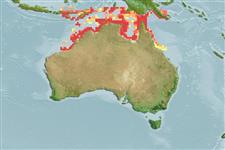>
Eupercaria/misc (Various families in series Eupercaria) >
Labridae (Wrasses) > Bodianinae
Etymology: Choerodon: Greek, choiros = a pig + odous = teeth (Ref. 45335); referrring to the prominent anterior canines of the species in this genus (Ref. 116605).
More on author: Ogilby.
Environment: milieu / climate zone / depth range / distribution range
Ecologia
marinhas demersal; intervalo de profundidade 10 - 40 m (Ref. 90102). Tropical
Western Central Pacific: northwestern Australia (Ref. 3131) and Papua New Guinea (Ref. 6192).
Tamanho / Peso / Idade
Maturity: Lm ? range ? - ? cm
Max length : 25.0 cm TL macho/indeterminado; (Ref. 3132)
Espinhos dorsais (total): 13; Raios dorsais (total): 7; Espinhos anais 3; Raios anais : 10. Body mostly pale with faint broad dusky bands especially dorsally. A prominent ocellated dark spot present on dorsal fin between last few spines. Body deep at level of dorsal-fin origin (2.3 to 2.6 times in SL). Second prominent anterior canine mostly straight, only slightly curved in large specimens, angled dorsolaterally and sometimes slightly posteriorly.
Adults inhabit flat sandy or weedy areas (Ref. 3131). Found solitary in rubble, silt or sand bottoms (Ref. 90102). Oviparous, distinct pairing during breeding (Ref. 205). A good food fish.
Ciclo de vida ou comportamento de acasalamento
Maturidade | Reprodução | Desova | Ovos | Fecundidade | Larvas
Oviparous, distinct pairing during breeding (Ref. 205).
Sainsbury, K.J., P.J. Kailola and G.G. Leyland, 1985. Continental shelf fishes of the northern and north-western Australia. An illustrated guide. CSIRO Division of Fisheries Research; Clouston & Hall and Peter Pownall Fisheries Information Service, Canberra, Australia. 375 p. (Ref. 3131)
Status na Lista Vermelha da UICN (Ref. 130435)
Warning: mysqli::__construct(): (HY000/1040): Too many connections in /var/www/html/includes/func_getlabel.php on line 46
Can't connect to MySQL database (fbapp). Errorcode: Too many connections
